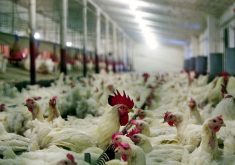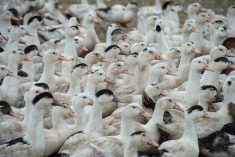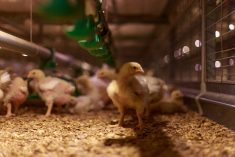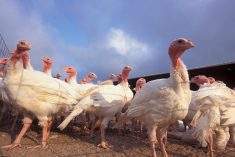Chicago | Reuters — A virulent strain of avian flu that has killed turkeys in the heart of the nation’s poultry region has been found through molecular testing to be nearly identical to viruses isolated in migratory ducks.
But some wildlife experts are skeptical of suggestions that wild birds are responsible for spreading the H5N2 flu strain that has infected poultry in Minnesota, Missouri and Arkansas.
A top investigator from the U.S. Department of Agriculture (USDA) says testing performed by the government supports a conclusion that the virus is being carried by waterfowl along an established migratory route that stretches south from Ontario and Canada’s eastern Prairies through Minnesota to the Gulf of Mexico.
Read Also

U.S. grains: Wheat futures slide on rising world production estimates
U.S. wheat futures fell more than one per cent on Wednesday to their lowest since late October on reminders of…
The virus can be transmitted to poultry from ducks through droppings that land on farms or when birds interact, among other ways.
“That’s the way we’re sort of pointing right now: to ducks as the problem,” said Brian McCluskey, lead epidemiologist for USDA’s Animal and Plant Health Inspection Service (APHIS). The agency has not, however, identified how the disease made its way from the ducks to domestic fowl.
Experts who doubt that wild birds are spreading the virus note that the disease has moved from Minnesota in the north, south to Arkansas and Missouri, the opposite direction birds migrate through the area in the spring.
“When you’re talking about where I would put my money, I would say that north to south movement in the beginning of March totally does not make sense,” said Hon Ip, a microbiologist for the National Wildlife Health Center.
Determining how avian flu is spreading is crucial to preventing future outbreaks, protecting poultry and limiting damage in the US$5.7 billion export market. Already, the outbreak has prompted top poultry importers, including Mexico and Canada, to widen trade restrictions.
Previous outbreaks on the U.S. West Coast were linked to wild fowl by the USDA. But the virus can be spread in other ways, too, including through contaminated trucks, humans or animal feed. People can carry infected material, such as feces or even feathers, to farms on their clothes, shoes or vehicles.
Once it arrives, avian flu can spread rapidly through a flock, killing birds in as little as 24 hours. The virus has not been identified in humans and is not expected to pose a public health risk, according to USDA.
The infection in a Minnesota turkey flock was the first along the migratory route known as the Mississippi flyway, which also includes Missouri and Arkansas — and continues southeast toward the major chicken producing states of Mississippi and Alabama.
After the Minnesota case was identified on March 5, USDA organized a call to advise state veterinarians along the route that the virus could be headed in their direction, said Richard Fordyce, director of Missouri’s Department of Agriculture.
“More toward biosecurity”
But wildlife experts question whether wild birds are moving the virus along the flyway.
“It is extraordinarily unlikely that avian influenza in the turkey flock in Minnesota has anything to do with wild birds,” said Lou Cornicelli, wildlife research manager for the Minnesota Division of Fish and Wildlife. He noted that few migratory ducks have started arriving in Minnesota.
“I would think the investigation is going to look more toward the biosecurity issue with food or transport,” Cornicelli added. “The fact that there are no ducks here would indicate that it’s not ducks in Minnesota.”
One day after USDA confirmed avian flu in Minnesota, state wildlife employees took a low-level airplane flight to scout a 25-km radius around an infected turkey farm for wild birds that could have carried the virus.
They spotted just 18 swans and 100 ducks, and they appeared to be “city birds” that do not migrate, Cornicelli said. The state nevertheless tested feces from some of the ducks for avian flu, but the results were negative.
Arkansas officials doubt the role of migratory birds in their state’s outbreak, too, partly because the area with the infected farm does not attract many wild birds and waterfowl, said Karen Rowe, bird conservation program leader for the Arkansas Game & Fish Commission.
Most birds in Arkansas are flying north at this time of year, Rowe added. She plans to travel to the farm next week to look for clues about how the virus could have spread.
“Was it carried in on clothing or boots? There’s just a lot of unanswered questions,” Rowe said.
Butterball LLC, which has contracts to buy turkeys from farms in Arkansas and Missouri that were infected, declined to speculate about how the virus was spread.
Cargill contracts for turkeys from an infected farm near Fortuna, Missouri, and said the origin of that infection is under investigation.
“We know that AI is spread by migratory wild waterfowl,” spokesman Michael Martin said, referring to the virus. “However, we are not taking anything for granted.”
— Tom Polansek reports on agriculture and ag markets for Reuters from Chicago.















